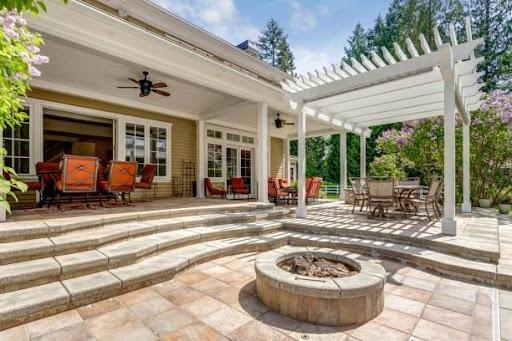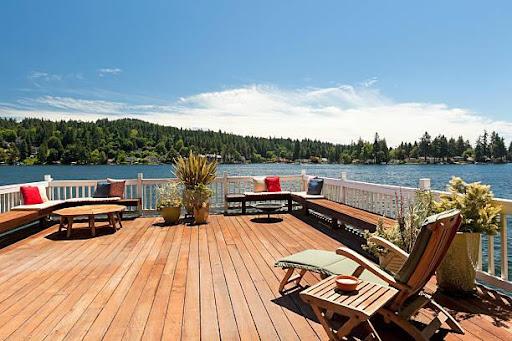Patio Vs Deck: Best Comparison
Decks and patios both help you make the most of your outdoor living space by allowing you to party, cook, and rest. Patios are put directly on the ground, whereas decks are elevated buildings with a support system underneath. Both are excellent options for establishing a relaxing outdoor living space.
Homes with these two additions have better resale values and are more appealing to purchasers than those without. You’re not alone if you can’t decide between a deck and a patio. Others, like you, are pondering what outdoor living area will best reflect their initial design ambitions.
Let’s look at some of the important differences between decks and patios so you can pick the one that’s right for you and your property.
What’s The Difference Between A Patio And A Deck?
Both decks and patios are great additions to your outdoor living space, there are a few major differences. Decks, for example, are typically built of wood, wood-look vinyl, or composite materials. Patios are typically composed of concrete, stone, or cement.
Patio
Patios are concrete-based outdoor dining areas that are flat with the ground. While concrete is the most common patio building material, you can also use pavers, stone, gravel, and other materials.
If you’re thinking of building a patio or deck, one of the most critical factors to consider is whether or not your ground is level. Patios must be on a flat surface because they are built on the ground. Alternatively, you might level the ground by shoring it up. (Great Day Improvements, 2020)
ProTip Takeaway: Modern-day Patios may include party features such as fire pits, built-in barbecues, and seating areas. This makes them ideal for relaxing and socializing.
Decks
Decks are raised structures that typically attach to your home. In the case of decking around a pool, it attaches to the pool for a seamless transition. Decks may be built on uneven and rocky terrain because they are raised above ground level, even if just by a few inches. Staining or sealing wooden decks every year or two is required to keep them in good shape.
When it comes to selecting the best decking material, there are numerous possibilities. The following are the most popular: Cedar, Bamboo, Mahogany, Redwood, Ipe, and Pressure-treated pine.
There are two types of decks.
While many people envision an elevated deck, it is also doable to have a deck at ground level. This deck differs from a patio in that it does not sit directly on the ground, whereas a patio does. A sturdy foundation is required for a well-constructed deck to handle the weight of furniture and visitors.
Read Also: How to Extend a Deck
Elevated Deck
Elevated decks extend from the main floor’s living and eating spaces in several neighborhoods. They operate well on sloping lots and other uneven ground because they’re elevated. This makes them suitable for raised homes or hilly places.
A ground-level deck
This deck is not totally level with the ground, despite its name. Even though these decks are low to the ground, a somewhat higher underpinning is required.
Ground-level decks frequently include a few steps for guests to access the deck comfortably. A ground-level deck also requires less upkeep than an elevated deck and does not require attachment to the house to be stable. (Fixr, 2017)
Deck Materials
The amount of durability of various decking materials varies. You can select between wood products that need to be power washed and sealed every couple of years. You can also choose manufactured products that require less maintenance but are more expensive upfront. Even if you choose a prefabricated product, the joists and stair stringers are still constructed of regular wood and will need to be sealed to last.
ProTip Takeaway: Planter boxes can be placed along the border of your deck, but they must be tiny.
Patio vs Deck Cost
The cost of constructing a deck is more than that of constructing a patio. The typical cost of establishing a patio is cheaper than that of installing a wooden or composite deck.
According to HomeAdvisor, the deck cost can range anywhere from $4,080 to $11,300 to build, with an average total cost of $7,700. This equates to $30-$60 per square foot.
Patios cost anywhere from $1,880 to $5,380, with an average cost of $3,620. This works out to around $8 to $20 per square foot.
Deck and patio installation costs depend on your location, terrain type, project size, and material selection. The deck builder or local patio contractor you hire will be able to provide you with precise quotations. They will also advise you on the best size and materials for your project. Making your patio a DIY project will help you save even more money.
Wood or bricks are more expensive and require more maintenance than stamped concrete or stone. Aside from the material, the cost of constructing a deck might be increased by the necessity for permits. (HomeAdvisor, 2021)
ProTip Takeaway: Keep in mind that the material, size, and location of your outdoor living space can all affect the project cost.
Requirements for obtaining a permit
Depending on where you live or are planning to buy a home, you may want to reconsider your deck option. Decks require inspections and permits from local building officials before they can be built. This is due to the additional professional effort that goes into constructing a deck. So make sure you verify local laws and obtain any necessary permits (if any).
A permit isn’t usually required to build a patio, though it’s a good idea to double-check with your local building department to make sure. Even if you don’t need a permit, a concrete patio may need extensive ground preparation before pouring the concrete. (Morgan Taylor Homes, 2021)
Patios Vs Decks Return on Investment (ROI)
Decks are more expensive to build upfront, but they have a better resale value than patios. These elevated constructions can add value to your house and make it more appealing to potential purchasers.
Decks and patios both increase the value of your home, but decks have a higher return on investment (ROI). When you sell your home, you may reclaim up to 50% of your investment in patios, but you can recoup up to 70% of your investment in a deck. (Nationwide, 2019)
Pros and Cons of Patios and Decks
|
Deck |
Patio |
|
Higher resale value There’s a 75% return on investment for a deck on average, higher than all indoor home renovations. |
Less expensive A patio that is flat with the ground can be substantially less expensive than a deck. Concrete is usually the least priced option, costing around $5 per square foot. |
|
Easy to customize You may paint or stain a hardwood deck to any color or tint you like. It can even be stained to match your home’s exterior style. |
Easy to maintain Patios do not need to be maintained on a regular basis. While sealing your patio is an option, it is not required because pavers and stone patios are incredibly durable. |
|
Performs admirably on uneven terrain. Decks can be built on any type of ground, even if it isn’t perfectly level. |
Long life expectancy A well-built patio can survive for more than 25 years and retain its value without requiring any maintenance. |
|
Permits may be required Many municipalities and cities have their own set of rules and may require a permit before constructing a deck. This may come with a charge and a waiting period. |
Permits are not required Installing a patio usually does not necessitate a construction permit or inspections. |
|
Offers a great view. Because a deck may be placed off the ground, it provides a superior view, which can boost the value of your home. |
More personal space Patios are lower to the ground and offer additional design and landscaping freedom for privacy. |
|
Expensive While the cost varies depending on the material, decks are often more expensive. High-end decking materials have an average cost of $30 per square foot. |
Not resistant to stains Because a patio’s surface is exposed to the elements, mud, mildew, and other natural stains such as leaves can discolor it. Patios must be cleaned on a regular basis. |
|
More upkeep is required Decks should be power washed, stained, and sealed every couple of years, depending on the material. |
Prone to cracks If the soil beneath the concrete isn’t adequately prepared, the patio is more likely to crack. Extreme temperatures increase the likelihood of cracking. |
Ready To Decide?
We hope this article has provided you with a better knowledge of the issues involved in deciding between a deck and a patio. Decks and patios, in either case, provide a favorable return on investment. They provide limitless opportunities for entertaining or simply relaxing in an outdoor setting.
Contact Smart Remodeling LLC in Houston today for the best decks and patios. Let us come and see how we can expand your living area with a deck or patio, so you can start living your life outside as well!
Are you ready to begin? Make an appointment with one of our patio or deck professionals for a free design consultation today! Contact us at 832 800 8889 or email us at sales@smartremodelingllc.com.









